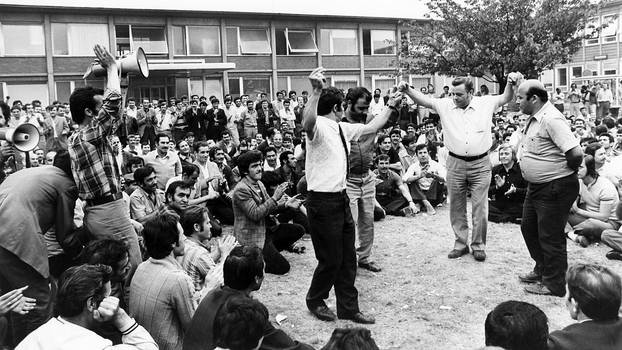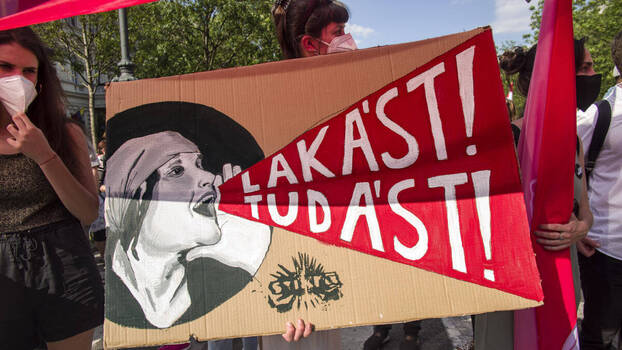Fifty years ago, diverse groups of workers began to connect anti-racism and class struggle
AUTHOR
Efsun Kızılay
 Striking Turkish workers at the Ford factory in Cologne-Niehl, 29 August 1973. The wildcat strike was triggered by the firing of 300 workers who returned home from vacation behind schedule, but in reality, it was about a lot more than that.
Striking Turkish workers at the Ford factory in Cologne-Niehl, 29 August 1973. The wildcat strike was triggered by the firing of 300 workers who returned home from vacation behind schedule, but in reality, it was about a lot more than that.Photo: picture alliance / UPI
Germany has seen a number of scandals and debates over the working conditions facing migrants from Eastern and Southern Europe in recent years. Hundreds of thousands travel to Germany each year to harvest vegetables, drive lorries, or work in factories. They generally are not represented by trade unions and earn less than their German colleagues. And frequently, they fight back, like the group of Georgian and Uzbek lorry drivers who, in early summer of this year, went on a wildcat strike after their employer refused to hand over their hard-earned wages.
Efsun Kızılay works on migration at the Rosa Luxemburg Foundation.
Yet poor working conditions for migrant workers in Germany is not a new phenomenon. These conditions have a long history — as do the struggles against them. Workers began protesting against unfair and inhumane conditions early on, demanding better working and living conditions as well as fair wages. They took labour disputes into their own hands, often carrying out wildcat strikes, independent of works councils, and in conjunction with struggles against racism and social marginalization.
These struggles first came to a head about 50 years ago, in the summer of 1973, when migrant workers in West Germany took a stand against over-exploitation and discrimination. To this day, their example continues to offer lessons on how anti-racism and class struggle can linked together.
Germany has seen a number of scandals and debates over the working conditions facing migrants from Eastern and Southern Europe in recent years. Hundreds of thousands travel to Germany each year to harvest vegetables, drive lorries, or work in factories. They generally are not represented by trade unions and earn less than their German colleagues. And frequently, they fight back, like the group of Georgian and Uzbek lorry drivers who, in early summer of this year, went on a wildcat strike after their employer refused to hand over their hard-earned wages.
Efsun Kızılay works on migration at the Rosa Luxemburg Foundation.
Yet poor working conditions for migrant workers in Germany is not a new phenomenon. These conditions have a long history — as do the struggles against them. Workers began protesting against unfair and inhumane conditions early on, demanding better working and living conditions as well as fair wages. They took labour disputes into their own hands, often carrying out wildcat strikes, independent of works councils, and in conjunction with struggles against racism and social marginalization.
These struggles first came to a head about 50 years ago, in the summer of 1973, when migrant workers in West Germany took a stand against over-exploitation and discrimination. To this day, their example continues to offer lessons on how anti-racism and class struggle can linked together.
West Germany’s Labour Agreements
West Germany’s expanding post-war economy faced a labour shortage that the federal government decided to combat through labour agreements with other countries. These were concluded in 1955 with Italy, in 1960 with Spain and Greece, in 1961 with Turkey, in 1963 with Morocco, in 1964 with Portugal, in 1965 with Tunisia, and in 1967 with Yugoslavia. These agreements, undertaken as the most cost-effective solution, did not anticipate the permanent presence in Germany of the workers they recruited; for this reason, they were labelled “guest workers”.
These guest workers were assigned primarily to “low-skill” jobs, often as contract workers on assembly lines, in construction, or in coal mines. The increasing affluence throughout all levels of West German society in the wake of World War II, known as the Fahrstuhleffekt (“elevator effect”), led to migrant workers’ being employed at the lower end of the hierarchy while Germans were able to ascend to higher-level occupations. The discrepancy between the two groups of workers was also apparent in their wages, which often diverged wildly.
The struggle over limitations on residence permits was successfully connected to the struggle over better housing conditions and industrial struggles and strikes, and a new anti-racist moment was born.
Resistance to poor and unfair working conditions began to grow among migrant workers. They began to unionize and take part in workplace demonstrations. Out of roughly 2 million migrant workers at the beginning of the 1970s, about one quarter were unionized. Many of these workers possessed a strong political consciousness. They came mostly from countries that were experiencing radical political upheavals. Greece, Portugal, and Spain had dictatorships until the mid-1970s, Turkey in the 1970s had a strong labour movement with countless strikes, and some of the workers arriving in Germany came from socialist Yugoslavia.
Workers from Greece organized resistance to the military junta from Germany, while workers from Turkey, where unions suffered state repression, started unions in Germany. From Italy, where the Communist Party was the second-largest party in parliament, workers brought extensive strike experience with them to Germany. In this way, migrant workers attempted to channel experiences from their countries of origin into labour struggles through union activity.
The Role of Unions and Autonomous Resistance
The existing trade unions initially perceived the recruited guest workers primarily as a new source of competition. This explains their reticence when it came to questions of being committed to and representing migrant workers. Since many migrant workers did not feel represented by the unions, between 1950 and 1970 they organized countless autonomous wildcat strikes independent of the unions. These wildcat strikes resulted both in schisms between German and migrant workers and successful solidarity-building between the groups.
Germans frequently met migrant workers with mistrust and scepticism. Many of the predominantly German works councils and trade unions refused to support migrants in labour disputes — their advancement within their companies was, after all, predicated on the fact that migrant workers would fill the lower ranks of company hierarchies. While German workers and unions were more interested in preserving company structures and so lent them their support, migrants frequently fought for changes to these structures and against their own exclusion. They criticized both racist conditions within the companies and poor housing conditions.
Their dissatisfaction eventually culminated in the waves of strikes that occurred in 1973. According to the editorial collective express, at least 275,000 workers at approximately 335 companies went on strike that year, spontaneously and independent of the unions. Spanish and Portuguese workers at the auto body manufacturer Karmann in Osnabrück, many of them women, stopped work to demand flexible working hours. Striking workers at John Deere in Mannheim were verbally berated and forced to protect themselves from physical attacks.
Although workers appealed to their employers primarily with demands for higher wages, they grew increasingly critical of the capitalistic structure of work as well. Workers at Valvo, a valve manufacturer in Aachen, and at the Hella automotive plant in Lippstadt, for example, demonstrated for a cost-of-living bonus and against wage discrepancies between German and migrant workers. The Lippstadt works council had previously won a cost-of-living bonus, but exclusively for German workers. Despite the fact that migrants included German workers in their demands, Germans rarely showed solidarity in migrant labour disputes. The Lippstadt Multinational Committee, which formed after the strike, openly opposed the company’s racist structures:
We are Greeks, Germans, Spaniards, and Italians; but regardless of our nationalities, we are all workers and we all face the same problems — or does the conveyor belt move faster for the Greek than for the German? We will not give management the satisfaction of seeing us divided because of the different colour of our hair and eyes.
The cost-of-living bonus was won for all, although in the end it was less than workers had demanded.
Resentment against poor working conditions was growing in many factories, erupting into various forms of resistance and protest. Disappointment spread regarding the restrained behaviour of the unions, and workers eventually refused to let them represent their demands. Two strikes in 1973 were particularly prominent: the women’s strike at automotive supplier Pierburg in Neuss, and the Ford strike in Cologne.
The Strike at Pierburg
The labour dispute at Pierburg took place in August 1973. It was one of the first successful strikes in West Germany against worker classification and compensation practices that discriminated against women.
One crucial element of the strike, and one of the factors that led to its success, was solidarity among the workers. Only a few days into the strike, German women technicians joined in solidarity with striking migrant women to oppose employers’ attempts at intimidation. With the demand of “One More Deutschmark”, 1,800 migrant and 400 German women workers staged an indefinite, spontaneous walkout.
Employers, the media, and even politicians attempted to criminalize the strike. It all began when Greek workers distributed leaflets in various languages calling for a strike. In response, police moved in to arrest the activists. During a scuffle, one police officer threatened them with a drawn pistol and hurled racist insults. As word of the violent, racist dimension of the police’s assault made its way around the factory, a wave of solidarity with the migrant workers immobilized the entire plant.
Fundamentally, labour disputes are always about more than labour disputes.
Despite racist company structures and a repressive management supported by both the press and the police, migrant workers were able to successfully call for solidarity and forge alliances. In doing so, they specifically sought out contact with German workers, for example by going to pubs they often frequented and recounting the racism they had suffered.
The strike was successful: the discriminatory Lohngruppe 2 was abolished, the lowest pay grade to which migrant women workers were assigned, with wages raised by 65 pfennigs per hour. Importantly, there were no lay-offs following the labour dispute.
It is important to mention that Pierburg already had a very active left-wing workers’ association before the strike. Many migrants already belonged to this association, which was in opposition to the works council of the time. In 1972, after years of work, it succeeded in winning more votes in factory-wide elections than the works council.
Members of the association accelerated the pace of their organizing work, regularly distributing information sheets in all the languages spoken in the factory. Multilingual representatives guaranteed the flow of information among workers, and even the workers’ assemblies were multilingual. All these developments and activities contributed to the strike’s success.
The Ford Strike
The best-known strike of 1973 was also carried out in August, at the Ford factory in Cologne’s Niehl district, where, about 11,000 workers from Turkey were employed between 1961 and 1973. They represented the largest “society of [Turkish-born] industrial workers outside of Turkey” and were given almost exclusively “unskilled” jobs. A sharp division therefore developed between these workers and the German workforce, who were mostly employed in better positions. The employment structure was based on a hybrid system in which migrant workers had to perform worse jobs, received worse pay, and could even be fired more easily than their German colleagues.
The catalyst for the strike was the firing of 300 workers who had returned late from vacation. But it was really about much more: prior to the firings, migrant workers had compiled lists of signatures petitioning the representatives of IG Metall, Germany’s largest metalworkers’ union, to campaign for a pay rise — yet the list was completely ignored in the next meeting of the workers’ association.
In the end, IG Metall reduced the migrant workers’ demands to a single one: cancelling their collective bargaining agreement. As Serhat Karakayalı writes, “As workers on a conveyor belt, most Turks earned an hourly wage between 7.15 and 8.24 marks, while Germans, as skilled labourers, earned between 8.98 and 10.59 marks.”
One week before the strike, a workers’ assembly took place at which the Turkish workers showed solidarity with those who had been laid off, while the majority of their German colleagues greeted the lay-offs and disciplinary actions with applause. When, in addition, the extra work resulting from the lay-offs was to be passed on to the remaining workers, their growing discontent was given voice through a train of protestors marching through the entire factory on 24 August 1973.
The subsequent strike lasted for seven days. More than half of the 33,000 employees took part, primarily Turks, although some German and Italian workers also supported the strike. The strikers’ demands were as follows: “decrease in conveyor belt speeds, reduction of the pace of work, better working conditions, six weeks of vacation, one more Deutschmark for all, the reinstatement of all those fired, and payment for striking hours”.
In the meantime, the works council was in unsuccessful talks with company management. When it then announced, “referencing industrial relations law and the ban on industrial action specified in the collective agreement”, that it would not support the strike, the works council forfeited any legitimacy it had in representing the interests of migrant workers. The union subsequently pursued a policy of division, which it shored up with demonstrations of its own. As a result, many German workers broke off and sided with the union. An alliance of trade union representatives, company management, press, city government, and police agitated against the striking migrant workers.
Migrant workers took their struggles into their own hands and, as political subjects, resisted the working and living conditions imposed upon them.
One week after the strike began, company management decided to use all available means to end it. During a counter-demonstration by German workers, management called in the police, who cracked down violently on the strikers and arrested their supposed ringleader. Baha Targün, spokesperson for the strike committee, was deported to Turkey. Management laid off 100 Turkish workers without notice, putting pressure on a further 600 to “convert [their] termination without notice to ‘voluntary’ termination”.
The works council did not object to any of these lay-offs. According to historian Jörg Huwer, “In the suppression of the strike, German workers’ anger erupted over the fact that Turkish migrants had, for a short time, been able to take control of their workplace.” Günter Piening explains:
At Ford, it was about “one more Deutschmark” … but at the same time, any halfway serious analysis shows that the great strike of August 1973 addressed all the conditions of life — including living quarters, the health problems caused by the work, and how you can keep in touch with family and friends when you have rotating shifts and just a few weeks of vacation. Fundamentally, labour disputes are always about more than labour disputes.
Beyond the Strike
Unfair, discriminatory structures were denounced outside of factories as well. Countless “multinational centres”, where migrants organized into work and cultural associations, formed across West Germany in those years. Migrants demanded the right to vote and protested police brutality and media attacks. As migration scholar Manuela Bojadžijev argues:
Migrants’ self-organized struggles against racist working and living conditions in Germany should therefore not be seen as single-issue movements. They connected the legal, political, and economic aspects of oppression and exploitation. They expanded narrow perspectives on labour struggles to encompass the entirety of the migrants’ experience, everyday life, language and culture, and no less importantly to housing conditions, which constituted the crucial focal point of migrant struggle alongside the factory.
The phenomenon of migrant workers’ strikes was of interest not only to the public, but also to the majority of those in the “old” and “new” Left. Huwer argues that their agitation and organization began to focus increasingly on migrant workers, “in [whose] life circumstances a new level of capitalist exploitation was to be seen, and at the same time the seeds of active resistance. In the eyes of the press, they filled the gap left by the unions, which had not yet succeeded in incorporating foreign workers into West Germany’s social partnership system of industrial relations.”
Structures of solidarity could therefore also be built with left-wing organizations. The Proletarische Front (Proletarian Front) in Hamburg and Bremen, the Arbeiterkampf (Workers’ Struggle) in Cologne, the Revolutionärer Kampf(Revolutionary Struggle) in the Frankfurt Rhein-Main area, and the Arbeitersache (Workers’ Cause) in Munich developed ideas for “multinational company work”. They had connections to the migrant organizations within companies as well as to autonomous migrant organizations, and migrant and student milieus drew closer to each other.
Migrant workers at steel manufacturer VDM in Frankfurt and at auto manufacturer Opel in Rüsselsheim stormed the German-dominated works council meeting with the slogan (developed by the Revolutionärer Kampf) “One Deutschmark for all!”. During housing struggles in Frankfurt, in which residents — a majority of them migrants — protested displacement and poor housing conditions, banners were also hung addressing poor working conditions. Karakayalı explains: “With the slogan ‘Fiat-Opel-Autobianchi die padroni siamo stanchi!’ (We’re tired of those tossers, the Fiat-Opel-Autobianchi bosses!), they also took on the capitalist instrumentalizing of migration.” The struggle over limitations on residence permits was successfully connected to the struggle over better housing conditions and industrial struggles and strikes, and a new anti-racist moment was born.
In this way, migrant workers took their struggles into their own hands and, as political subjects, resisted the working and living conditions imposed upon them.
Translated by Anna Dinwoodie and Marty Hiatt for Gegensatz Translation Collective.

 Members of the left-wing group Szikra demonstrate against the Orbán government’s plan to bring Chinese Fudan University to Budapest, 5 June 2021
Members of the left-wing group Szikra demonstrate against the Orbán government’s plan to bring Chinese Fudan University to Budapest, 5 June 2021
